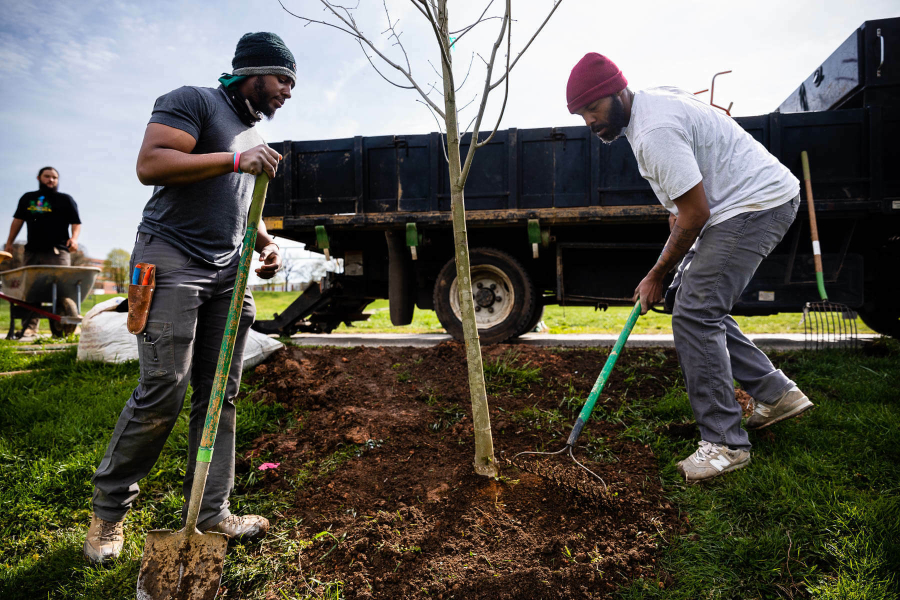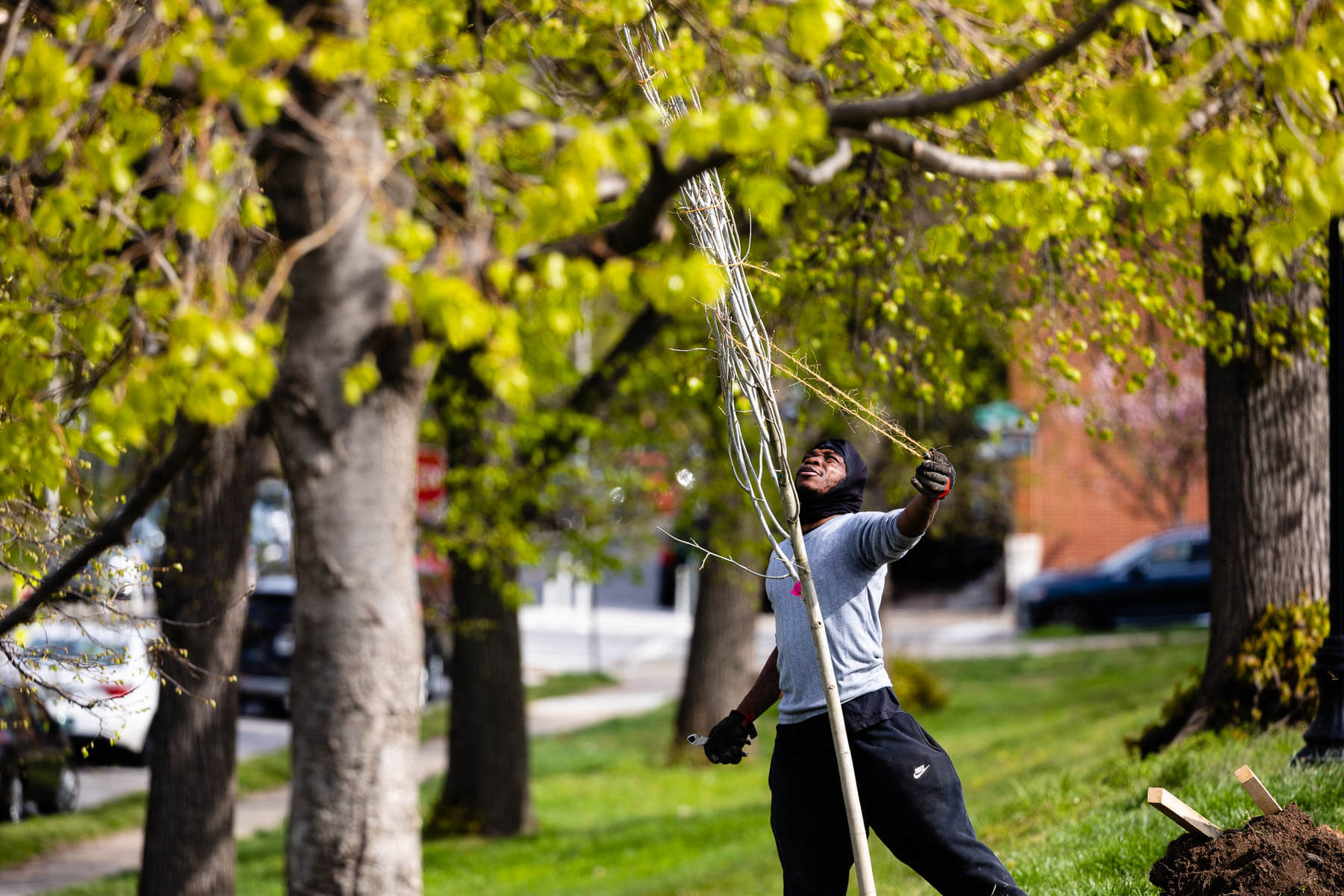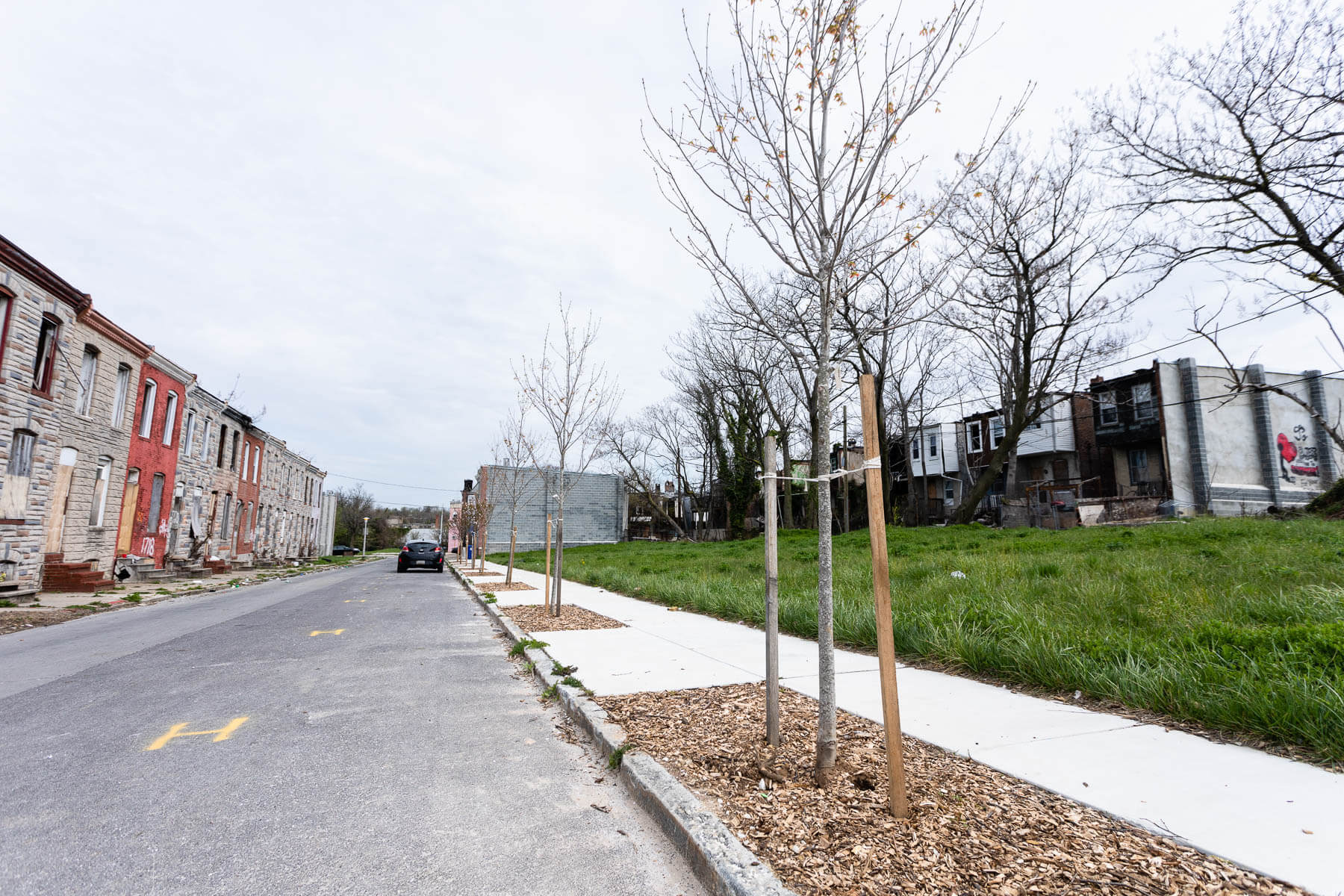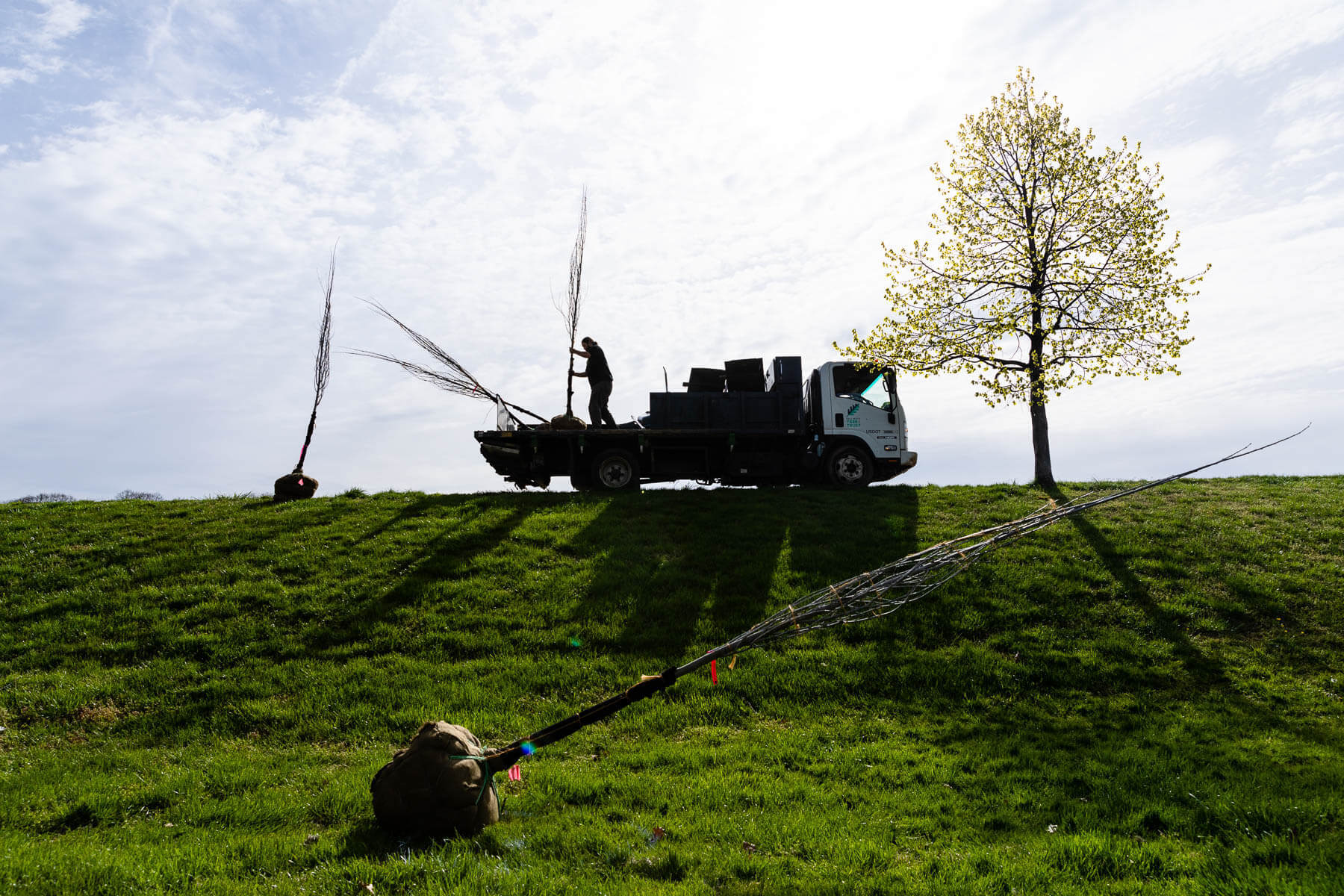A nonprofit rooted in Baltimore uplifts the city with trees

As far as urban tree plantings go, the spring morning at Patterson Park is a breeze. There’s no concrete to break up or skeptical residents to coordinate with. The crew at Baltimore Tree Trust gets to work planting rows of American baswood while the team truck, adorned with the sticker “Trees on the Way,” plays a bit of music.
“I love these kinds of days,” said Materials Handler Allen George, a Baltimore native who goes by the name, Mookie.
The nonprofit is planting the last of 71 trees put in the park over a four day stretch, working through Friends of Patterson Park. With 155 acres of land, Patterson Park has plenty of room for trees; the type of site that’s key to meeting Maryland’s goal of planting and maintaining five million trees by 2031.
Though as much as the Baltimore Tree Trust team enjoys these park plantings, the nonprofit truly shines with street plantings—going into neighborhoods to remove heat reflecting concrete and add much needed natural shading.
Over the past four years, the nonprofit has worked in dozens of Baltimore City neighborhoods doing street plantings. In 2018, they received funding from the Chesapeake Bay Program’s Small Watershed Grants to plant 275 street trees and remove 8,800 square feet of impervious surface. Funded by the Environmental Protection Agency and administered by the National Fish and Wildlife Federation, these grants are awarded to local governments and non-governmental organizations working to protect and improve local waters and habitats across the Bay watershed.
In a city where neighborhoods without trees can be up to 16 degrees hotter than those with them, this work is of high importance. It’s the reason nonprofits like the Baltimore Tree Trust were formed—and what inspires them to keep up the challenging work.

Breaking ground
In many ways, Baltimore Tree Trust has been the perfect partner to carry out the city’s street plantings.
First and foremost, they are a highly skilled group led by experts in urban forestry. Chief Executive Officer Bryant Smith, Chief Operating Officer Justin Bowers and Director of Neighborhood Forestry Elliot Weidow have a combined 40 years of experience in forestry, working at a variety of regional nonprofits and state and federal agencies.
That experience has allowed the nonprofit to grow and become a trusted resource for challenging work. Street plantings are infinitely more complicated than planting in a park and require a highly competent crew. You need to use heavy machinery to bust up the concrete, be aware of water pipes, power lines and sewers underground, and most of all, reassure residents that you know what you’re doing.
“We have to know what we’re doing and why we’re doing it,” said Mookie. “That’s part of our job.”
The nonprofit also works hard to engage residents before trees are even planted. According to Communications and Outreach Manager Ryan Alston, Baltimore Tree Trust will find key community stakeholders and leaders who can put them in touch with neighborhood groups. This way, they’re able to listen to and address any concerns residents have about new trees.
“We work hard to create buy-in that’s really needed to do this work,” said Alston.
The nonprofit provides a two year warranty on the trees and checks in monthly to ensure they’re adjusting well. They talk with residents to communicate the benefits of trees and reassure them that they’ll do their best to keep them maintained.
“I’ll even hand out my card,” said Kwamel Couther, a tree planting foreman.

From the city they plant in
Perhaps most importantly, the crew at Baltimore Tree Trust represents the people who live in the neighborhoods they plant in.
In Baltimore, the tree canopy is lowest in communities at the city’s urban core, which tend to be disproportionately African American. Of the nonprofit’s 25 staff members, 11 are African American and most were born in Baltimore.
This makes it easier to create trust in communities that are wary of public works projects. Many neighborhoods in Baltimore have been subject to new developments that residents were never engaged in, as well as tree plantings that weren’t done right or were never properly maintained.
“We see a lot of community members that have been in this neighborhood their entire lives,” Alston said of a community in East Broadway. “So they take a lot of pride in the neighborhood but they’re also really particular about the work that goes on.”
In addition to its full-time team, Baltimore Tree Trust brings in Baltimore residents through its Neighborhood Foresters Initiative. Through this program, the nonprofit provides career readiness training to Baltimore city residents ages 18 and above, who are facing difficult employment challenges. During the first six months of the program, members learn the necessary educational requirements to pass the Maryland Licensed Tree Expert exam. After a year, members are eligible to become a crew leader.
Currently, eight full-time staff members came through the Neighborhood Foresters Initiative, including Mookie.
Mookie was born in Baltimore, but as a kid, child protective services removed him and he was sent to live on Maryland’s Eastern Shore. Now back in the city, Mookie gets to improve the neighborhoods he grew up in.
“Makes me feel good when I ride past,” said Mookie.

An environmental and public health issue
In Baltimore, most waterways lead to the Patapsco River, a major tributary of the Chesapeake Bay. Planting trees and removing impervious surfaces reduces the amount of nutrient runoff, which feeds algae blooms that die and decompose, resulting in low-oxygen conditions known as “dead zones.”
However, the issue goes far beyond water quality. The Baltimore neighborhoods with fewer trees are the same ones that were subject to early 20th century redlining, in which financial institutions withheld loans and other services based on location versus individual qualifications. Redlined neighborhoods were predominantly low-income and communities of color.
“If you overlay a tree canopy map you really see the same kinds of things,” said Alston.
The Baltimore Tree Trust crew is well aware of these disparities because many of them experienced them growing up. Couther grew up in east Baltimore in a neighborhood that had no vegetation or green space of any kind on his block.
“It sucks,” said Couther. “It’s hot, it raises your gas and electric, AC has to work harder to keep your house cool. Now I live in Better Waverly and have a beautiful American elm in front of my house and it’s different. My air barely comes on.”

Comments
There are no comments.
Thank you!
Your comment has been received. Before it can be published, the comment will be reviewed by our team to ensure it adheres with our rules of engagement.
Back to recent stories